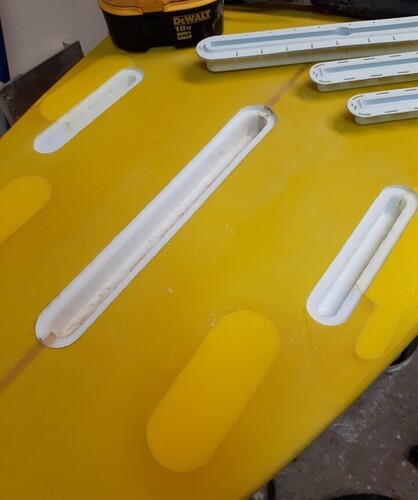I assume we are discussing the futures boxes shown below? Not telling or suggesting what to do, just saying what I do. I freehand these with a little Bosch trim router (shown in the 2nd pic). The board shown didn’t have any extreme bottom contours.
I just marked the locations carefully with pencil, and took my time. I did the center slots fist, being careful but not stressing cuz this part doesn’t show.
Then the shallower part. First pass at half depth, staying about 1/16th inside my lines. Next pass at full depth, carefully sneaking up to the line. Just like coloring in a coloring book, take care to stay inside the lines.
A few more passes, gradually deeper, are called for when routing a stringer. Don’t try to scarf out big bites.
I have worked with hand held power tools pretty much my whole life, and do not find this difficult. I always maintain dominant control of any hand held power tool, and always try to think through what COULD happen, and act accordingly.
Not bragging, cuz I could get hurt tomorrow, stuff happens, but just saying I have never had a power tool injury in 40 years in the remodeling industry, and lots of creative home projects over the years. I do not fear power tools, but I maintain a healthy respect.
Always proceed with caution using ANY power tool, and do not attempt anything you are not comfortable and confident with.
Edited to add: thinking back, I remember now I did the stringer slot with a forstner bit on a hand held drill, just drilling my holes edge to edge for the length of the slot. I started each time with a spade bit until I got thru the fiberglass, then switched to forstner bit to finish drilling. Then cleaning up at the end with the router.






